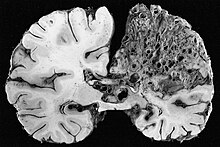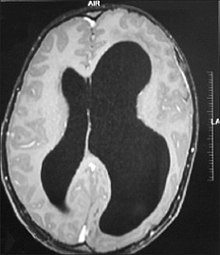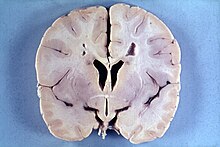Causes
Below is a list of causes of macrocephaly from Swaiman's pediatric neurology: principles and practice noted in The Little Black Book of Neurology [1] [2]:
I. Hydrocephalus

Noncommunicating:
- Arnold-Chiari malformation
- Aqueductal stenosis
- X-linked hydrocephalus with stenosis of the aqueduct of Sylvius (HSAS) syndrome ( L1CAM)
- Dandy-Walker malformation
- Galenic vein aneurysm or malformation
- Neoplasms, supratentorial, and infratentorial
- Arachnoid cyst, infratentorial
- Holoprosencephaly with dorsal interhemispheric sac
Communicating:
- External or extraventricular obstructive hydrocephalus ( dilated subarachnoid space)
Arachnoid cyst, supratentorial
Meningeal fibrosis/obstruction:
- Postinflammatory
- Posthemorrhagic
- Neoplastic infiltration

Vascular:
Choroid plexus papilloma
Neurocutaneous syndromes:
Destructive lesions:
Familial, autosomal-dominant, autosomal-recessive, X-linked

II. Subdural Fluid
III. Brain Edema (Toxic-Metabolic)
- Intoxication
- Lead
- Vitamin A
- Tetracycline
- Endocrine ( hypoparathyroidism, hypoadrenocorticism)
- Galactosemia
- Idiopathic ( pseudotumorcerebri)

IV. Thick Skull or Scalp (hyperostosis)
- Familial variation
- Anemia
- Osteoporosis, severe precocious autosomal-recessive osteoporosis ( CLCN7, TCIRG1)
- Pycnodysostosis ( CTSK)
- Craniometaphyseal dysplasia ( ANKH)
- Craniodiaphyseal dysplasia
- Pyle dysplasia
- Sclerosteosis ( SOST)
- Juvenile Paget disease
- Idiopathic hyperphosphatasia
- Familial osteoectasia
- Osteogenesis imperfecta
- Rickets
- Cleidocranial dysostosis
- Hyperostosis corticalis generalisata ( van Buchem disease)
- Proteus syndrome
V. Megalencephaly and hemimegalencephaly

Diagnosis
Macrocephaly is customarily diagnosed if head circumference is greater than two standard deviations (SDs) above the mean. [3] Relative macrocephaly occurs if the measure is less than two SDs above the mean, but is disproportionately above that when ethnicity and stature are considered.
Relative macrocephaly is likely to have been inherited by one or both parents and is considered benign or megalencephaly and is not associated with neurological disorders [4]. Diagnosis can be determined in utero or develop within eighteen 18-24 months after birth in some cases where head circumference tends to stabilize in infants [5]. Diagnosis in infants includes measuring the circumference of the child's head and comparing how significant it falls above the 97.5 percentile of children similar to their demographic and then check if there is any intracranial pressure present in the child [4]. If a patient is suspected of having macrocephaly molecular testing will be used to confirm diagnosis.
Neurodevelopment is also assessed for all cases and suspected cases of macrocephaly to determine if and what treatments may be needed and whether or not other syndromes may be present or likely to develop.
Treatment
Treatment varies depending on whether or not it occurs with other medical conditions in the child and where cerebrospinal fluid is present [5].
- If benign and found between the brain and skull then no surgery is needed [5].
- If excess is found between the ventricle spaces in the brain then surgery will be needed [5].
Syndromes with Macrocephaly
Below is a list of syndromes associated with macrocephaly. [6]


Include multiple major and or minor anomalies:
- Acrocallosal Syndrome
- Apert Syndrome
- Bannayan-Riley-Ruvalcaba
- Cardiofaciocutaneous syndrome
- Chromosome 14 - maternal dismoy
- Chromosome 22qter deletion
- Cleidocranial dysostosis
- Costello syndrome
- Encephalocraniocutaneous lipomatosis
- FG syndrome
- Hailermann-streiff syndrome
- Hydolethalus syndrome
- Hypomelanosis syndrome
- Hypomelanosis of Ito
- Kelvin Peter anomaly plus syndrome
- Lujan-fryns syndrome
- Macrocephaly-CM (MCAP)
- Marshall-Smith syndrome
- Neuhauser megalocornea/MR syndrome
- Neurofibromatosis I
- Nevoid basal cell carcinoma syndrome
- Noonan syndrome
- Ocular-ectodermal syndrome
- Osteopathia striata - cranial sclerosis
- Perlman syndrome
- Ritscher - schinzel syndrome
- Robinow syndrome
- Simpson-golabi-behmel syndrome
- Sotos syndrome
- Sturge-Weber syndrome
- Weaver syndrome
- Wiedermann-rautenstrauch syndrome
Secondary to a metabolic disorder:
- Glutaric aciduria type II
- GM1 gangliosidosis
- Hunter syndrome
- Hurler syndrome
- MPS VII
- Sanfilippo syndrome
- Zellweger syndrome
Associated with a skeletal dysplasia:
- Achondroplasia
- Camptomelic dysplasia
- Craniodiaphyseal dysplasia
- Craniometalphyseal dysplasia
- Hypochondrogenesis
- Hypochondroplasia
- Kenny-caffey
- Kniest syndrome
- Lenz-majewski
- Osteogenesis imperfecta III
- Osteopetrosis, autosomal recessive form
- Schneckenbecken dysplasia
- Sclerosteosis
- Short rib syndrome, beemer-langer type
- Short rib-polydactyly 2 (majewski type)
- Spondyleopiphyseal dysplasia congenita
-
Thanatophoric dysplasia

Alexander disease

With no obvious physical findings:
- Alexander disease
- Canavan
- Cobalamin deficiency (combined methylmalonic aciduria and homocystinuria)
- Dandy-Walker malformation
- Glutaric aciduria I
- L-2 hydroxglutaric aciduria
- Megalencephalic leukoencephalopathy
- Osteogenesis imperfecta IV
- Osteopathia striata-cranial sclerosis
- Periventricular heterotopia
- Sandhoff disease
- Tay-sachs
-
^ Cooke, Rachel.
"ProQuest Ebook Central". CC Advisor. Retrieved 2020-04-20.
{{ cite web}}: CS1 maint: url-status ( link) - ^ Swaiman, Kenneth F.; Ashwal, Stephen; Ferriero, Donna M.; Schor, Nina F. (2012), "Preface to the Fifth Edition", Swaiman's Pediatric Neurology, Elsevier, pp. xiii–xiv, ISBN 978-1-4377-0435-8, retrieved 2020-04-20
- ^ Fenichel, Gerald M. (2009). Clinical Pediatric Neurology: A Signs and Symptoms Approach (6th ed.). Philadelphia, PA: Saunders/Elsevier. p. 369. ISBN 978-1416061854.
- ^
a
b
Signs and symptoms of genetic conditions : a handbook. Hudgins, Louanne,, Toriello, Helga V.,, Enns, Gregory M.,, Hoyme, H. Eugene,. Oxford.
ISBN
978-0-19-938869-1.
OCLC
879421703.
{{ cite book}}: CS1 maint: extra punctuation ( link) CS1 maint: others ( link) - ^
a
b
c
d
"Macrocephaly | Nicklaus Children's Hospital". www.nicklauschildrens.org. Retrieved 2020-04-11.
{{ cite web}}: CS1 maint: url-status ( link) -
^
Signs and symptoms of genetic conditions : a handbook. Hudgins, Louanne,, Toriello, Helga V.,, Enns, Gregory M.,, Hoyme, H. Eugene,. Oxford.
ISBN
978-0-19-938869-1.
OCLC
879421703.
{{ cite book}}: CS1 maint: extra punctuation ( link) CS1 maint: others ( link)
See also
Causes
Below is a list of causes of macrocephaly from Swaiman's pediatric neurology: principles and practice noted in The Little Black Book of Neurology [1] [2]:
I. Hydrocephalus

Noncommunicating:
- Arnold-Chiari malformation
- Aqueductal stenosis
- X-linked hydrocephalus with stenosis of the aqueduct of Sylvius (HSAS) syndrome ( L1CAM)
- Dandy-Walker malformation
- Galenic vein aneurysm or malformation
- Neoplasms, supratentorial, and infratentorial
- Arachnoid cyst, infratentorial
- Holoprosencephaly with dorsal interhemispheric sac
Communicating:
- External or extraventricular obstructive hydrocephalus ( dilated subarachnoid space)
Arachnoid cyst, supratentorial
Meningeal fibrosis/obstruction:
- Postinflammatory
- Posthemorrhagic
- Neoplastic infiltration

Vascular:
Choroid plexus papilloma
Neurocutaneous syndromes:
Destructive lesions:
Familial, autosomal-dominant, autosomal-recessive, X-linked

II. Subdural Fluid
III. Brain Edema (Toxic-Metabolic)
- Intoxication
- Lead
- Vitamin A
- Tetracycline
- Endocrine ( hypoparathyroidism, hypoadrenocorticism)
- Galactosemia
- Idiopathic ( pseudotumorcerebri)

IV. Thick Skull or Scalp (hyperostosis)
- Familial variation
- Anemia
- Osteoporosis, severe precocious autosomal-recessive osteoporosis ( CLCN7, TCIRG1)
- Pycnodysostosis ( CTSK)
- Craniometaphyseal dysplasia ( ANKH)
- Craniodiaphyseal dysplasia
- Pyle dysplasia
- Sclerosteosis ( SOST)
- Juvenile Paget disease
- Idiopathic hyperphosphatasia
- Familial osteoectasia
- Osteogenesis imperfecta
- Rickets
- Cleidocranial dysostosis
- Hyperostosis corticalis generalisata ( van Buchem disease)
- Proteus syndrome
V. Megalencephaly and hemimegalencephaly

Diagnosis
Macrocephaly is customarily diagnosed if head circumference is greater than two standard deviations (SDs) above the mean. [3] Relative macrocephaly occurs if the measure is less than two SDs above the mean, but is disproportionately above that when ethnicity and stature are considered.
Relative macrocephaly is likely to have been inherited by one or both parents and is considered benign or megalencephaly and is not associated with neurological disorders [4]. Diagnosis can be determined in utero or develop within eighteen 18-24 months after birth in some cases where head circumference tends to stabilize in infants [5]. Diagnosis in infants includes measuring the circumference of the child's head and comparing how significant it falls above the 97.5 percentile of children similar to their demographic and then check if there is any intracranial pressure present in the child [4]. If a patient is suspected of having macrocephaly molecular testing will be used to confirm diagnosis.
Neurodevelopment is also assessed for all cases and suspected cases of macrocephaly to determine if and what treatments may be needed and whether or not other syndromes may be present or likely to develop.
Treatment
Treatment varies depending on whether or not it occurs with other medical conditions in the child and where cerebrospinal fluid is present [5].
- If benign and found between the brain and skull then no surgery is needed [5].
- If excess is found between the ventricle spaces in the brain then surgery will be needed [5].
Syndromes with Macrocephaly
Below is a list of syndromes associated with macrocephaly. [6]


Include multiple major and or minor anomalies:
- Acrocallosal Syndrome
- Apert Syndrome
- Bannayan-Riley-Ruvalcaba
- Cardiofaciocutaneous syndrome
- Chromosome 14 - maternal dismoy
- Chromosome 22qter deletion
- Cleidocranial dysostosis
- Costello syndrome
- Encephalocraniocutaneous lipomatosis
- FG syndrome
- Hailermann-streiff syndrome
- Hydolethalus syndrome
- Hypomelanosis syndrome
- Hypomelanosis of Ito
- Kelvin Peter anomaly plus syndrome
- Lujan-fryns syndrome
- Macrocephaly-CM (MCAP)
- Marshall-Smith syndrome
- Neuhauser megalocornea/MR syndrome
- Neurofibromatosis I
- Nevoid basal cell carcinoma syndrome
- Noonan syndrome
- Ocular-ectodermal syndrome
- Osteopathia striata - cranial sclerosis
- Perlman syndrome
- Ritscher - schinzel syndrome
- Robinow syndrome
- Simpson-golabi-behmel syndrome
- Sotos syndrome
- Sturge-Weber syndrome
- Weaver syndrome
- Wiedermann-rautenstrauch syndrome
Secondary to a metabolic disorder:
- Glutaric aciduria type II
- GM1 gangliosidosis
- Hunter syndrome
- Hurler syndrome
- MPS VII
- Sanfilippo syndrome
- Zellweger syndrome
Associated with a skeletal dysplasia:
- Achondroplasia
- Camptomelic dysplasia
- Craniodiaphyseal dysplasia
- Craniometalphyseal dysplasia
- Hypochondrogenesis
- Hypochondroplasia
- Kenny-caffey
- Kniest syndrome
- Lenz-majewski
- Osteogenesis imperfecta III
- Osteopetrosis, autosomal recessive form
- Schneckenbecken dysplasia
- Sclerosteosis
- Short rib syndrome, beemer-langer type
- Short rib-polydactyly 2 (majewski type)
- Spondyleopiphyseal dysplasia congenita
-
Thanatophoric dysplasia

Alexander disease

With no obvious physical findings:
- Alexander disease
- Canavan
- Cobalamin deficiency (combined methylmalonic aciduria and homocystinuria)
- Dandy-Walker malformation
- Glutaric aciduria I
- L-2 hydroxglutaric aciduria
- Megalencephalic leukoencephalopathy
- Osteogenesis imperfecta IV
- Osteopathia striata-cranial sclerosis
- Periventricular heterotopia
- Sandhoff disease
- Tay-sachs
-
^ Cooke, Rachel.
"ProQuest Ebook Central". CC Advisor. Retrieved 2020-04-20.
{{ cite web}}: CS1 maint: url-status ( link) - ^ Swaiman, Kenneth F.; Ashwal, Stephen; Ferriero, Donna M.; Schor, Nina F. (2012), "Preface to the Fifth Edition", Swaiman's Pediatric Neurology, Elsevier, pp. xiii–xiv, ISBN 978-1-4377-0435-8, retrieved 2020-04-20
- ^ Fenichel, Gerald M. (2009). Clinical Pediatric Neurology: A Signs and Symptoms Approach (6th ed.). Philadelphia, PA: Saunders/Elsevier. p. 369. ISBN 978-1416061854.
- ^
a
b
Signs and symptoms of genetic conditions : a handbook. Hudgins, Louanne,, Toriello, Helga V.,, Enns, Gregory M.,, Hoyme, H. Eugene,. Oxford.
ISBN
978-0-19-938869-1.
OCLC
879421703.
{{ cite book}}: CS1 maint: extra punctuation ( link) CS1 maint: others ( link) - ^
a
b
c
d
"Macrocephaly | Nicklaus Children's Hospital". www.nicklauschildrens.org. Retrieved 2020-04-11.
{{ cite web}}: CS1 maint: url-status ( link) -
^
Signs and symptoms of genetic conditions : a handbook. Hudgins, Louanne,, Toriello, Helga V.,, Enns, Gregory M.,, Hoyme, H. Eugene,. Oxford.
ISBN
978-0-19-938869-1.
OCLC
879421703.
{{ cite book}}: CS1 maint: extra punctuation ( link) CS1 maint: others ( link)